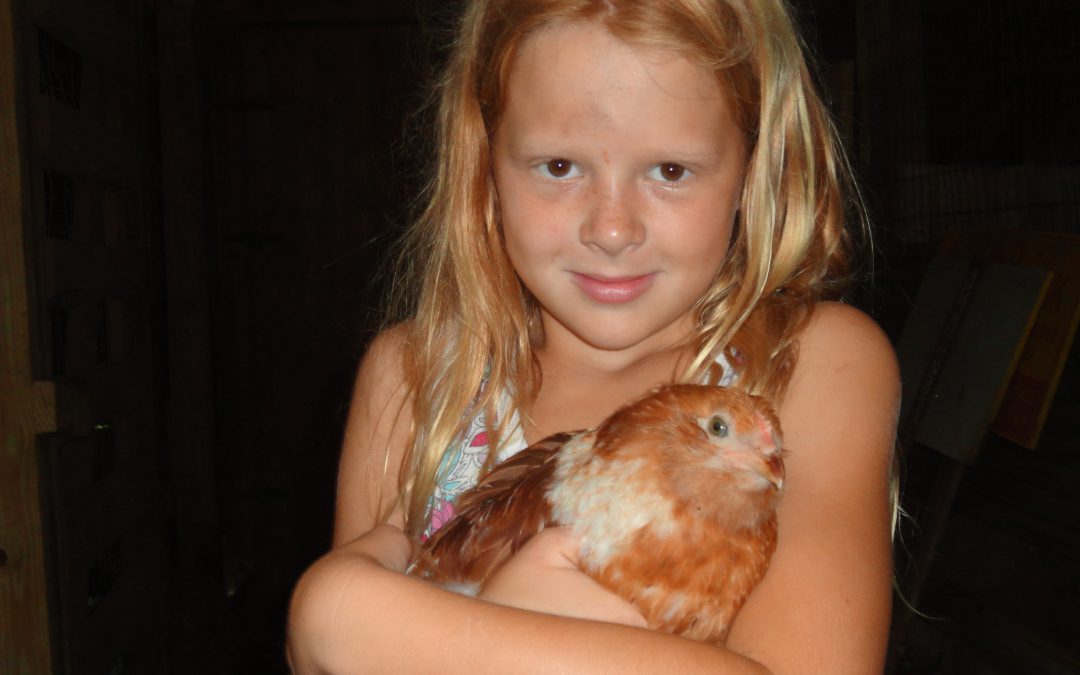
by Julie Pigott Dillard | Sep 13, 2019
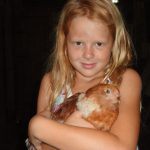
Learning responsibility is just one of the many skills learned through 4-H Chick Chain.
Since March, 4-Hers have watched their chicks grow day by day into pullets. Spanning six months, the 4-H Chick Chain project teaches youth how to care for growing chickens. They’ve learned all about nutrition, housing needs, and disease management along with showmanship preparation and practices. Youth kept project books of their experiences, taking note of expenses, and breed information. Youth who participated in the past 2018 project have continued to care for their chickens who are now laying eggs and providing a food source for their family.
On September 28th, youth will participate in the 2019 4-H Chick Chain Show. For 2019 projects, youth will exhibit two of their best project pullets (a pullet is less than one year old at laying age), participate in showmanship to show off their handling skills, and enjoy a skill-a-thon to show what information and knowledge they’ve learned during the year. For 2018 projects, those youth will bring their two best layers which are now in peak egg production.

Best of Breed winners from the 2018 4-H Chick Chain
2019 4-H Chick Chain Show Details
For youth participating in the 2019 4-H Chick Chain Show, remember to register through your 4HOnline profile by midnight, September 13th. Your project book and photography entries are also due to your 4-H agent that day.
Youth will earn awards in skill-a-thon and showmanship. Awards will be given to best of breed and overall champions will be named.
Here’s a timeline of events for the 2019 4-H Chick Show:
Saturday, September 28, 2019
Washington County Ag Center – 1424 Jackson Ave, Chipley, FL – check-in on the west end of the building.
- If your flock is NPIP certified, bring your card to check-in
- 8-8:30 am – District II Check-in (Walton, Washington)
- 9-9:30 am – District III Check-in (Leon, Liberty, Jefferson, Wakulla, Franklin, Gadsden)
- 10-10:30 am – District I Check-in (Escambia, Okaloosa, Santa Rosa)
As soon as birds are checked-in, youth will participate in showmanship and skill-a-thon with awards tentatively scheduled for 12 pm.
Resources:
by Prudence Caskey | Feb 2, 2017
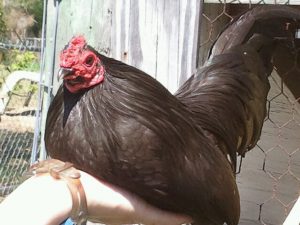 The term “Backyard Chickens” is one many people use today. The idea of having a pet help you make breakfast is growing in popularity. I am often questioned as to which breed of chicken is the best breed. When asked, I always reply, “What do you want the chicken to do?” The reason I ask is because The American Poultry Association recognizes 65 different breeds of chickens. Each breed can meet a different need. Many people will blurt out, “I want eggs!” Well, do you care what color eggs? Do you care how often you get eggs? Does the size of the egg matter? Each breed is different and there are pros and cons to each breed. Some of the more popular breeds that you can find at your local feed store during upcoming “Chick Days” are described below:
The term “Backyard Chickens” is one many people use today. The idea of having a pet help you make breakfast is growing in popularity. I am often questioned as to which breed of chicken is the best breed. When asked, I always reply, “What do you want the chicken to do?” The reason I ask is because The American Poultry Association recognizes 65 different breeds of chickens. Each breed can meet a different need. Many people will blurt out, “I want eggs!” Well, do you care what color eggs? Do you care how often you get eggs? Does the size of the egg matter? Each breed is different and there are pros and cons to each breed. Some of the more popular breeds that you can find at your local feed store during upcoming “Chick Days” are described below:
- Rhode Island Red: This is a breed that is a large-bodied bird that lays a large to extra-large brown egg. These hens are very personable and can have a great personality. This breed can become a pet in no time.
- White Leghorn: This particular bird will lay a large white egg on a very regular basis. The Leghorn is not friendly and is often referred to as “flighty”. Leghorns will not, as a general rule, become pets. They will lay you an egg almost daily, but will run from you when it’s time to collect those eggs.
- (Buff) Orpington: Usually sold in the color buff, additionally available in other colors. This is a large-bodied friendly bird. Orpingtons can become fast friends and will serve as a dual-purpose member of your flock. This means that they are great egg layers, and will also serve as a good meat bird if the desire or need arises.
- Sex-link varieties: With this breed, you will not get a breed, but they have great production. Sometimes called Red Star, or Black Star, the chicks show a difference when day old chicks. It will be easy to determine between the two. If chicks are not your thing, you can always purchase young hens that are just starting to lay.
Many people are not ready to wait five to six months to get their beloved eggs from their new pets. If that is the case, you can always check with your local extension office to inquire if a local 4-H member might have some young hens for sale. On September 30th, 4-H members from across the panhandle will have a “Chick Chain” show and Auction. Save the date and get the best breed for you!
If you have children between the ages of 5-18 (as of September 1st, 2016) and you are interested in starting a backyard flock, you may want to sign up for the 4-H Chick Chain. This program teaches youth how to raise, care for, and show chickens. Registration is open February 1st-24th via 4HOnline. Youth will receive 12, day-old pullets on March 29th. Throughout the spring and summer, youth will learn the ins and outs of poultry farming, and how to market their eggs and hens for profit. They will keep business and health records, learn about bio-security, and gain poise, confidence, and communication skills while showing their hens in the fall. For more information, contact your local UF IFAS County Extension Office, or read about last year’s program.
4-H Poultry Project
4-H Embryology Project
4-H Chick Chain
Poultry Breeds:
Care of Baby Chicks
Factors Affecting Egg Production in Backyard Chicken Flocks
Intestinal Parasites in Backyard Chicken Flocks
Prevention and Control of Fowl Pox in Backyard Chicken Flocks
Small Flock Poultry Nutrition
Vaccination of Small Poultry Flocks
by Whitney Cherry | Oct 27, 2016
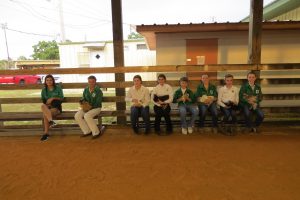
4-Hers are waiting for their moment with the poultry judge. Photo Credit: Misty Smith
I am often asked, “How do you wash a chicken?” I reply, “Just like a turkey, only on a smaller scale!” But for many 4-H’ers, washing chickens is part of showing chickens and is a skill they have to master.
Raising and showing poultry is quickly becoming a hobby for people of all ages. Youth who are active in a 4-H poultry project, are already one step ahead of the rest. Not only do they learn about poultry health, bio-security, and nutrition, they also learn about sportsmanship and other aspects of the poultry industry through showmanship. Many UF/IFAS Extension Offices offer day camps and clinics to help youth learn how to raise and show poultry, so contact your local office for more information- there’s one in every county! Here are a few steps 4-H youth can take to prepare for a poultry show:
Step 1: Handle your chicken daily. By handling your chicken daily, this will ensure that it is used to people, and will be friendly to the judge. A friendly chicken shows the judge that the chicken’s owner has been dedicated to preparing the bird for showing, not just ignoring it and bringing it to the show on show day.
Step 2: Practice holding your chicken. There is a correct way to hold a chicken when you are showing it and you will need to practice, practice, practice. When you and your bird feel comfortable around each other, you can start practicing holding and walking around with the bird the correct way, by placing your middle and fourth finger between the bird’s legs. Using your first finger and pinkie, hold the bird’s wings down. For carrying, put the bird’s head under your arm. When youth practice holding and carrying their bird, the bird becomes very docile and calm which makes for a great show chicken.
Step 3: Know the parts of the chicken. This step is one of the hardest in the entire showmanship procedure.
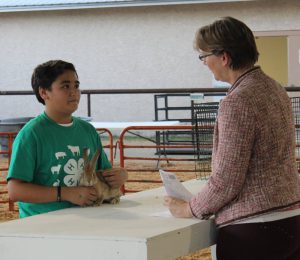
Poultry Showmanship can help youth build communication skills and confidence. Photo Credit: Julie Dillard
It is based on simply remembering the steps and practicing with your bird. Youth are quizzed on the parts of the chicken and whoever knows the most, does the best. Make sure you know about the head, wings, under color, width of body, breast, vent, abdomen, pubic bone, legs and feet, and how to cage a bird. All of these will ensure to the judge that youth have studied about their bird and are very knowledgeable on the parts of a chicken. Also, know about the breed of your chicken. You will want to do your homework on the breed of chicken that you are showing so any questions that the judge may ask about your bird you will know how to answer correctly.
Step 4: Know how to bathe your chicken. The easiest way to bathe a chicken is with a 5 gallon bucket of lukewarm water and dish soap. You want to “dip” the chicken 2-3 times in the soapy water, avoiding getting the head wet, and then dip them in clean water to rinse them off. Never submerge a chickens head in the water due to the fact that the chicken can aspirate and die. If your chicken’s head is soiled, use a wet cloth to wipe it clean. The chicken will take care of the rest by preening itself so make sure that you bathe the chicken 48 hours prior to the show so that there will be time for natural oil replacement. Place your chicken in a wire cage to ensure it stays clean before the show.
Step 5: Have fun! Showing chickens is a great and rewarding experience for youth. Poultry shows are a great opportunity for youth to demonstrate their skills, gain confidence, make lifelong friends and practice responsibility. The 4-H poultry project can be the spark that leads youth to a career in animal science industry where the possibilities are endless!
Do you have a passion for poultry? If so, consider using your knowledge, skills and interests as a 4-H poultry volunteer. We could use your expertise planning shows, teaching workshops and helping youth experience success with their poultry project. Contact your local UF/IFAS Extension Office or visit http://florida4h.org for more info.
Recommended Resources for Poultry Showmanship:






